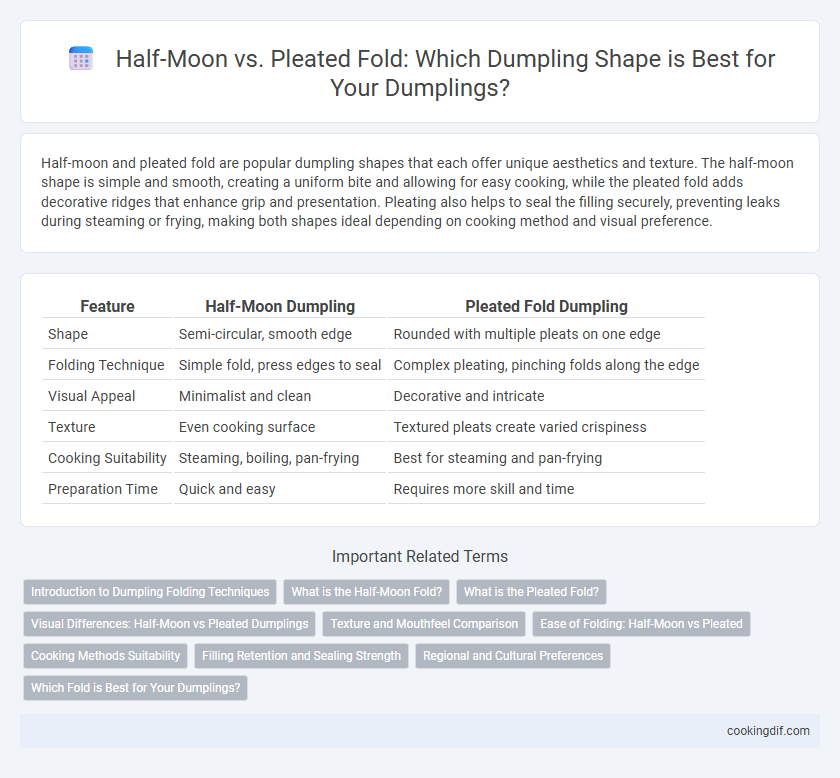Half-moon and pleated fold are popular dumpling shapes that each offer unique aesthetics and texture. The half-moon shape is simple and smooth, creating a uniform bite and allowing for easy cooking, while the pleated fold adds decorative ridges that enhance grip and presentation. Pleating also helps to seal the filling securely, preventing leaks during steaming or frying, making both shapes ideal depending on cooking method and visual preference.
Table of Comparison
| Feature | Half-Moon Dumpling | Pleated Fold Dumpling |
|---|---|---|
| Shape | Semi-circular, smooth edge | Rounded with multiple pleats on one edge |
| Folding Technique | Simple fold, press edges to seal | Complex pleating, pinching folds along the edge |
| Visual Appeal | Minimalist and clean | Decorative and intricate |
| Texture | Even cooking surface | Textured pleats create varied crispiness |
| Cooking Suitability | Steaming, boiling, pan-frying | Best for steaming and pan-frying |
| Preparation Time | Quick and easy | Requires more skill and time |
Introduction to Dumpling Folding Techniques
Half-moon and pleated fold represent two fundamental dumpling folding techniques, each influencing texture and cooking outcomes. The half-moon fold involves sealing a circular wrapper into a simple crescent shape, offering a smooth edge suitable for boiling or steaming. In contrast, the pleated fold adds intricate ridges by pinching multiple folds along the edge, creating a firmer seal ideal for pan-frying and enhancing presentation.
What is the Half-Moon Fold?
The Half-Moon fold is a simple dumpling shape that forms a smooth, crescent-shaped edge by folding a circular wrapper in half and sealing the edges without pleats. This fold offers a clean, uniform appearance that is easy to execute and ideal for retaining juicy fillings. In comparison to the intricate Pleated Fold, the Half-Moon fold emphasizes speed and simplicity while maintaining a satisfying texture when cooked.
What is the Pleated Fold?
The pleated fold is a traditional dumpling shaping technique where small, even pleats are pinched along one side of a circular wrapper, creating a decorative, ruffled edge that seals the filling securely. This method enhances the dumpling's texture by adding a delicate chewiness to the edges and improves structural integrity, preventing fillings from leaking during cooking. Compared to the simpler half-moon fold, the pleated fold offers an aesthetically pleasing presentation and a more authentic appearance in East Asian cuisine.
Visual Differences: Half-Moon vs Pleated Dumplings
Half-moon dumplings feature a smooth, curved edge with a simple, clean fold that creates a crescent shape, emphasizing a minimalist and uniform appearance. Pleated dumplings showcase intricate, tightly packed folds along the edge, resulting in a textured, ruffled look that adds visual complexity and elegance. These distinct folding techniques influence the overall aesthetic, with half-moon shapes appealing to those preferring sleek simplicity, while pleated folds attract attention for their detailed craftsmanship.
Texture and Mouthfeel Comparison
The Half-moon dumpling shape offers a smooth, uniform texture with tender edges that create a soft bite, enhancing the overall mouthfeel by allowing the filling's flavors to stand out. In contrast, the Pleated Fold provides a slightly thicker, chewier texture along the ridges, adding a satisfying contrast that balances firmness and softness. This textured variation in pleated folds often results in a more complex mouthfeel, combining crisp edges with a chewy dumpling body.
Ease of Folding: Half-Moon vs Pleated
Half-moon dumplings offer a straightforward folding process requiring only a simple fold and seal, making them more accessible for beginners or quick preparation. Pleated fold dumplings demand more precision and practice, involving multiple small folds to create a decorative edge that ensures a tighter seal, reducing the risk of filling leakage. For ease of folding, half-moon shapes provide a faster, less intricate option, while pleated folds prioritize aesthetic and durability, often preferred by experienced cooks.
Cooking Methods Suitability
The half-moon dumpling shape offers a sturdy structure ideal for boiling and steaming, ensuring even cooking without breaking. In contrast, pleated fold dumplings provide multiple layers that better trap juices, making them perfect for pan-frying to achieve a crispy texture and juicy interior. Selecting the appropriate fold influences cooking results, with half-moon excelling in steaming and pleated folds favored for frying techniques.
Filling Retention and Sealing Strength
The half-moon dumpling shape offers a sturdy seal with a simple fold, providing moderate filling retention suitable for less moist fillings. In contrast, the pleated fold enhances sealing strength through multiple tucks, creating a tighter closure that effectively prevents leakage during cooking. Pleated folds are preferred for juicy or loose fillings, ensuring maximum filling retention and structural integrity.
Regional and Cultural Preferences
Half-moon dumplings, widely favored in northern Chinese cuisine, are characterized by their simple, sleek appearance that highlights the filling's flavor, whereas pleated folds are more prevalent in southern China and Japan, showcasing meticulous craftsmanship and often used for festival dishes. The pleated fold demonstrates regional artistry, creating a textured, visually intricate dumpling that holds thicker fillings and is associated with celebratory occasions like Lunar New Year. Cultural preferences influence table presentation and taste expectations, with the half-moon's minimalistic style preferred for everyday meals and the pleated offering symbolizing tradition and ceremonial significance.
Which Fold is Best for Your Dumplings?
Half-moon folds offer a simple, clean edge that ensures even cooking and a balanced filling-to-wrapper ratio, making them ideal for beginners and quick meals. Pleated folds provide a decorative, textured edge that securely seals the dumpling, preventing leaks and enhancing presentation, which suits chefs aiming for aesthetics and precision. Choosing the best fold depends on whether you prioritize ease and speed or visual appeal and sealing strength in your dumplings.
Half-moon vs Pleated Fold for dumpling shape Infographic

 cookingdif.com
cookingdif.com